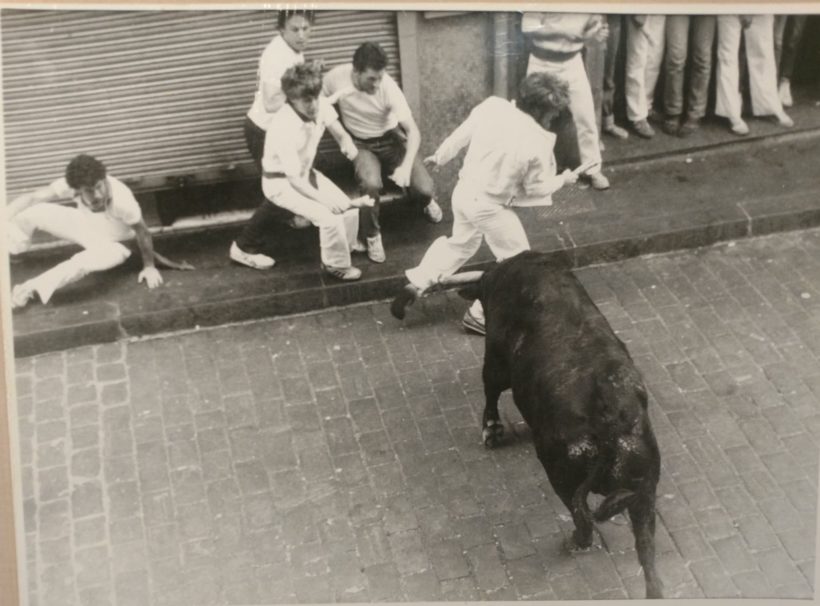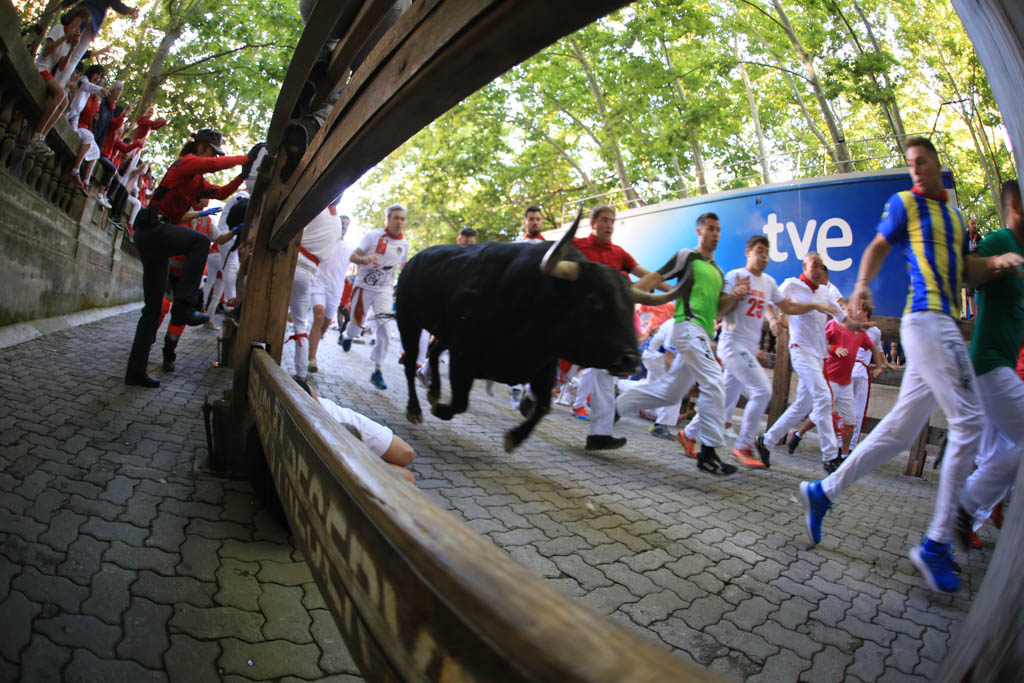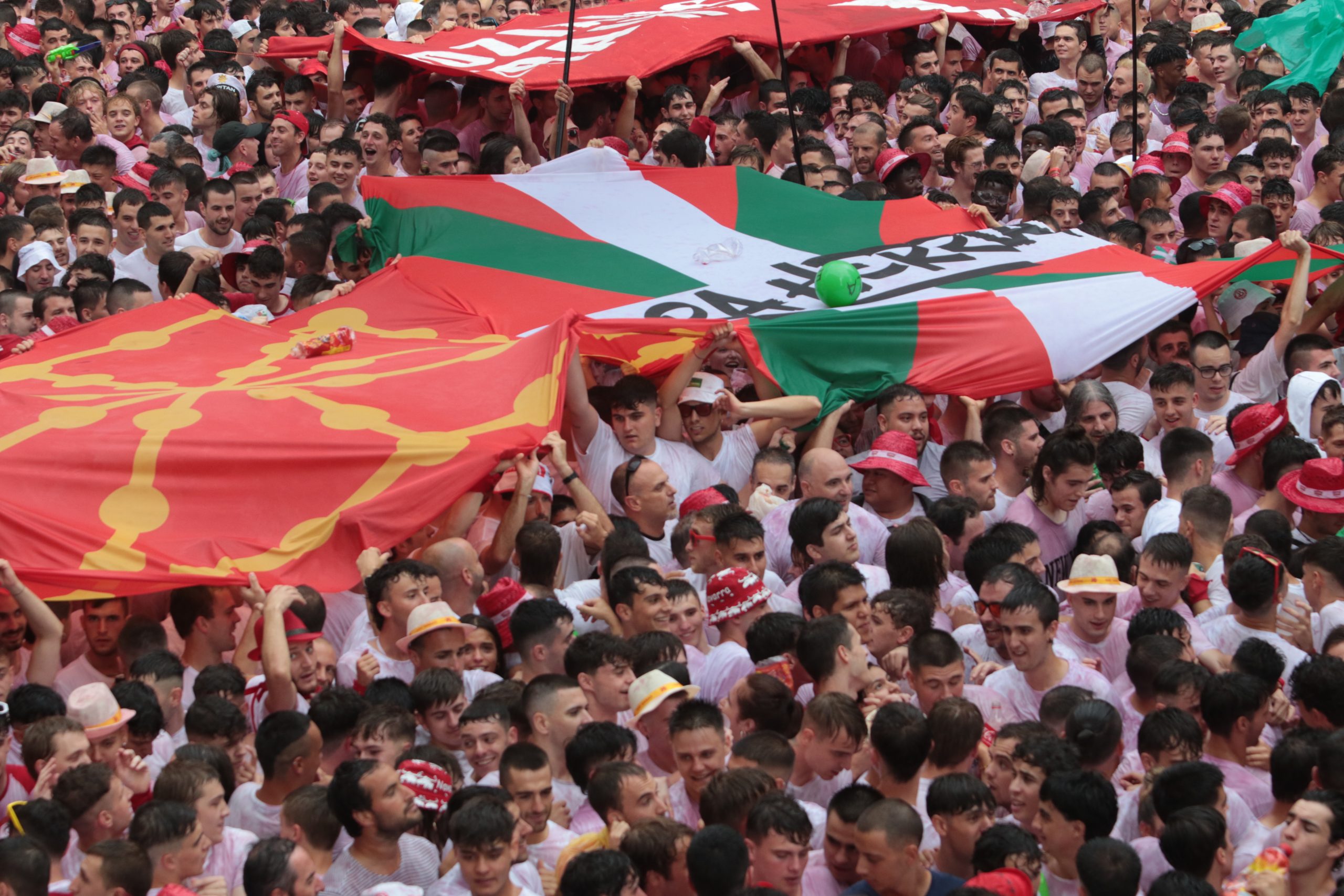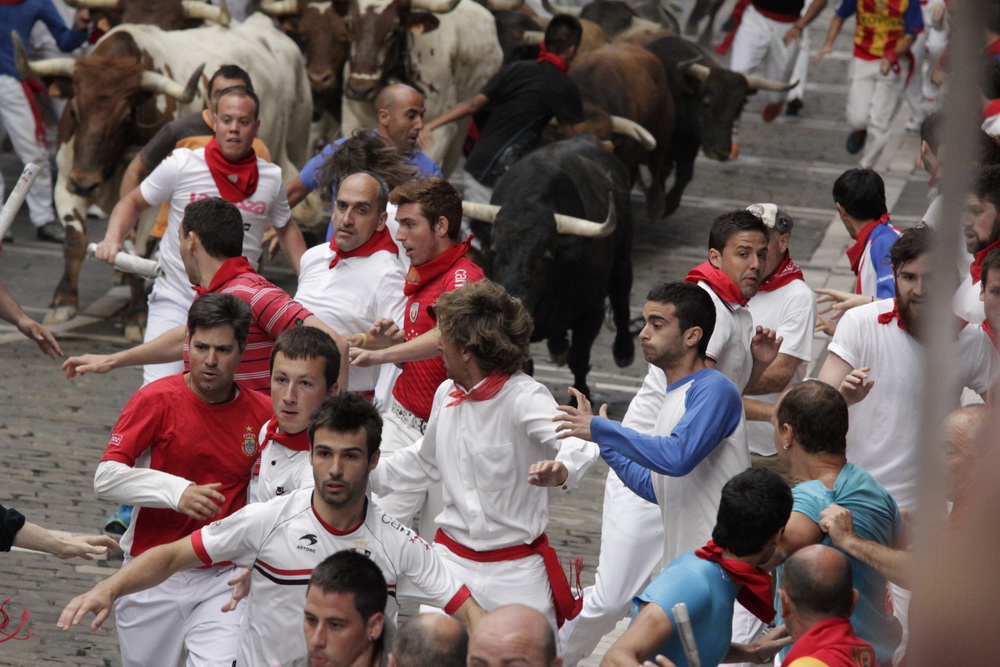There was a contingent of Garmisch adventurers that went to Pamplona every year for the Festival of San Fermin. Bomber was the most experienced runner in the group and told great stories about prior years and the close calls with the horns and riots between Basque locals and the police and military. The first time I heard him talk about Pamplona was when we were getting stoned together in Uganda in the shade of the Sikh temple wall, where they had come looking for a place to stay, but were turned away. I was immediately hooked on the idea of going to Pamplona and running with the bulls and was thinking about Spain when he and Goldie left me to walk through Kampala (3 miles with their packs) to the other Sikh temple to see if they had room for them to stay. The sun was going down and I worried for them. Very few people were on the street at night, it was a dangerous city after dark in 1983.
My friend Shred had somehow finagled vacation time from the kayak school and also wanted to go. A group of us rented a car and planned to leave Saturday, July 7 and drive straight though until we arrived in Spain. Robert was doing most of the driving and Mick was riding shotgun, and claimed that seat for the whole ride. Shred, Steamboat John and me in the back. We left in the afternoon traveling through the mountains of Austria and Switzerland then to Lyon and south through Pau and then crossing the snow capped Pyrenees at Candanchu and then into Spain and Jaca and finally Pamplona on the evening of the 9th. There were other caravans from Garmisch also making the trip and we were the last to arrive. We walked into Plaza Castillo just as the bullfights were letting out and the Pena bands were parading through the plaza. We found Bomber and Goldie other Garmischers drinking red wine from botas and sitting on the curb, across from the Bar Txoco. It was about 10PM and the sun was just setting. It was warm and the town was alive with people coming from the bull fight to find a table on the square and watch the paseo from a comfortable vantage point with bebidas. Our plan was to buy some wine and fill up our botas and then walk the bull run course from start to finish. Bomber led the way out of the plaza to the bull ring and then down Calle Estafeta, the longest portion of the run. At the bottom of the street past La Curve and through Calle Mercaderes past the mayor’s palace and down Calle Santo Domingo, to the beginning of the bull run where the corales for the bulls are. The pen was full of the next days animals and the police kept things quiet down here, so as not to allow drunks to disturb the bulls.
We went for a drink at Bomber’s favorite place, Le Mejillonera, the Mussel Bar. It was in the sketchy part of town on Plaza Navarreria. People were diving off the statue in front of the bar into the waiting arms of the crowd below. The street was full of trash and plastic cups and bottles. The crowd was rough and the neighborhood was dirty. This is where the punk rockers and misfits of fiesta were hanging out. Not the place to bring your Mom at night. It smelled like urine and puke. People were lighting fireworks and throwing torpedoes that exploded on impact. There were no police to be seen down here. The beer was cheap and we hung out for a few hours watching the the underbelly of fiesta in front of us, before heading out of town to where we were camping that night, near the waterfalls.
We were up at six and back in Pamplona before seven. All our bags were still in the car and we decided that somebody had to stay with the vehicle to guard our stuff. It was a hard choice and in the end John volunteered to stay. Just at that moment Louise and the girls pulled up in their car and parked next to us. Louise generously offered to stay behind and freed John to run the bulls.
I went to the square first and found a bathroom to relieve myself. We all met in front of the mayor’s palace and waited for 8AM. At 7:45 they let us walk up the street through Mercaderes around La Curve and up the canyon like street of Estafeta with six story buildings lining the street. Once you started up the street there was no exit until you reached the top, four hundred meters uphill. We found our spots to stand at the top of Estafeta where it gets wider. The next section curves left for about 200 meters and then funnels down to the left into the narrowest portion, a bottleneck tunnel called the callejon, leading into the bull ring.
I found a perch in the niche of a doorway on the left and waited with a few thousand others. Ten minutes gave me plenty of time to question my resolve. My mouth was dry and I was sweating and could smell the bad breath and stink of hangover wafting through the dense crowd around me. The sound of giddy laughter and incessant chatter identified the very nervous. There were others who were obviously veterans, who calmly read the newspaper with a quite smile just as if they were waiting for a bus on their day off. The cobblestone street was wet from the morning dew. We were all wearing red scarves around our necks and half of the crowd was dressed all in white. Basque flags were everywhere. The police were posted along the fence to prevent runners from vaulting the barricades, unless there was a bull goring someone, then they tried to pull them over the fence and out of harm’s way if they could.
There was a group of locals moving through the crowd looking for women. I saw them take the hat off a girl, revealing her long hair, and then picking her up and tossing her over the barricade and warning her to stay out. There was a long tradition of expelling women from the encierro. I only saw this once and it was a dying tradition in 1984. Plenty of girls snuck in and ran however.
The first rocket went off at exactly 8AM. This signals that the gate of the corrales has been opened. Twenty seconds later a second rocket explodes, letting us know that all the animals are out of the pen and running in the street. The crowd starts to thin out and many runners have run into the bull arena, before the bulls are any where near them. These runners are sarcastically referred to as, “Los Valientes” or the brave ones. At one minute, you can hear the crowd react to the bulls coming up the street, at the bottom of Estafeta. The runners near me are jumping up and down , trying to see the vanguard of the approaching bulls. The crowd gets louder and starts moving faster as it passes me. I see the first two bulls go by and then I jump into the flow of runners chasing the lead bulls ahead of us, and in front of the bulls behind us. I swerved left to avoid fallen runners and ran up on the curb around the pile of fallen bodies. A Bull has fallen and the runners in front of me have stopped and are staring down a lone bull to the right, that has just gotten to its feet and is about to charge at us. I am against the wall with two others, when I see what was about to happen.
Time had slowed down and I was starting to back up when a runner ran between the bull and where I was on the curb. The bull looked to its right and saw another lone runner against the wall and charged, impaling Steven Townsend in the groin and lifting him into the air. When he landed the bull charged again and gored him in the thigh, rupturing his femoral artery. A famous picture of this moment circulated around the world on the front page of the International Herald Tribune showing Townsend in all his agony, screaming with the bull looking him in the eye as it trampled over him. The bull charged again and again, goring and tossing Steve until he was in shock and had almost bled out. His blood was everywhere. It was one of the worst gorings in the history of San Fermin. There were two other bulls also trying to gore people further up the street in a section called Teléfonos. I watched this all happen in front of me and was scared of being the victim as well. I was about to climb under the barricade, but stopped and forced myself to stay in the street. Just then I saw a fourth bull ten meters to my right. I ran to the left, around the far side of the bull goring Townsend, up the street where the other two bulls were causing havoc. I slowed down a bit and saw an opening and ran by the lead bull towards the tunnel, through the callejon.
The bulls I had run by had caught up to me and were close when I came into the plaza de toros. It was dusty and crowded and the audience was screaming as I entered. I was winded and my mouth was so dry that I could hardly talk. The bulls eventually came into the arena where the doubledores used their capes to lead the animals through the plaza toward the Toril and into their pens. Most runs are over in 2-3 minutes, but today’s encierro was much longer and had many lone bull/goring situations in the street. Back where I had started, Steven Townsend, 1st. Lt. US Army, was being saved by the experienced trauma teams who were waiting in the wings, watching as the carnage unfolded. As soon as Townsend was free of his tormentor, a doctor wearing sterile gloves had squeezed through the wooden barricade and immediately started first aid. He put his hand inside the gaping thigh wound and grabbed the pulsing femoral artery which stopped the hemorrhage and saved his life. He needed 14 pints of whole blood to sustain him through surgery. From the time he was gored to the time he was operated on, was less than 20 minutes. This rapid response and the experienced and well prepared emergency services were the reasons he didn’t die from his injuries. After fiesta I heard that Townsend had been court martialed and charged with destroying government property. It was his first run as well and I was standing right next to him just before he was gored.
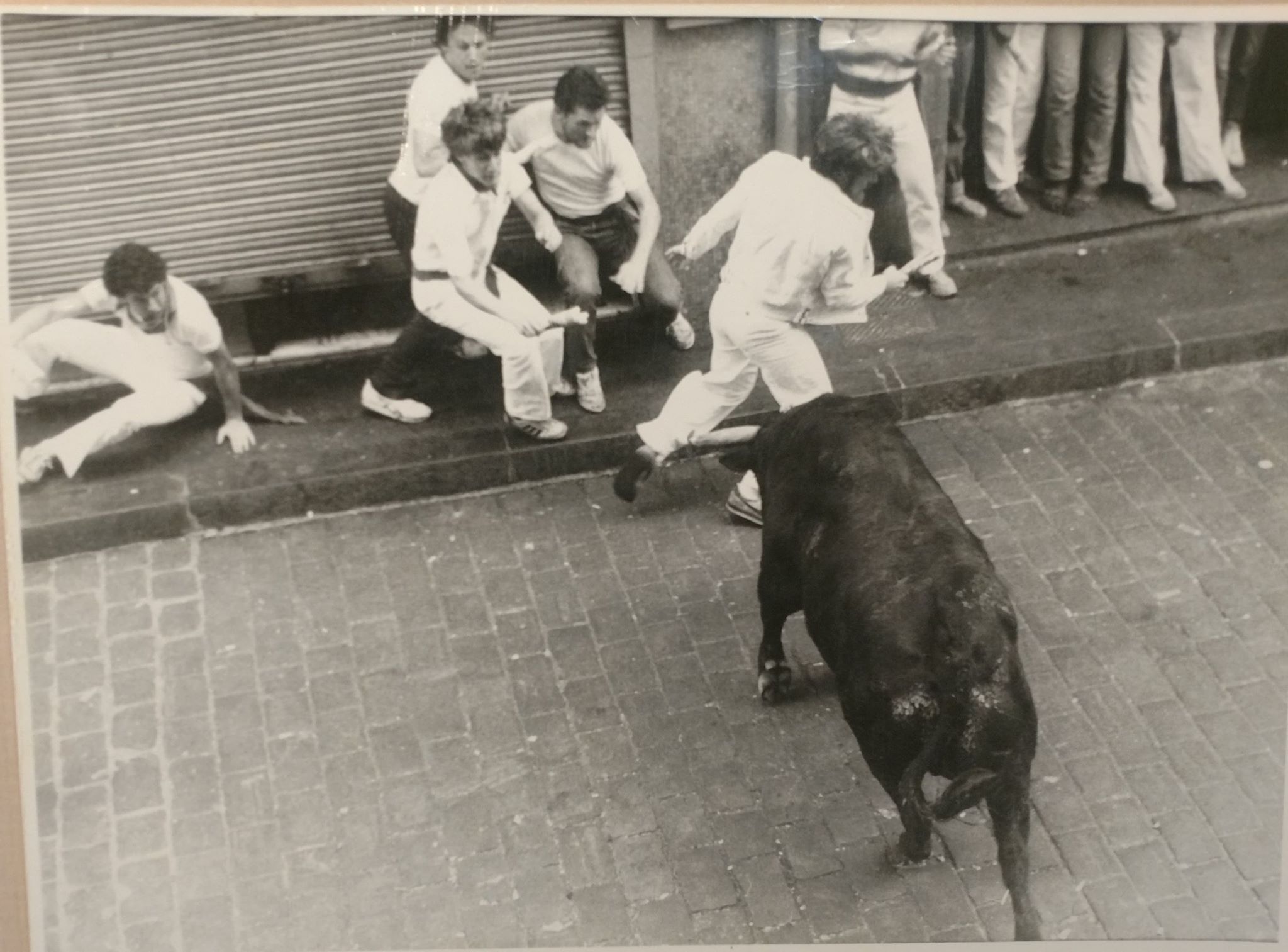
I was still in the arena, trying my luck dodging the smaller and faster vacas running around with padded horns, not as dangerous as the fighting bulls we just ran with. My throat was so dry that it hurt. My pants were ripped and I was covered in dust. The other Garmischers in the arena were in shock for how violent the days run had been. Some of them had run in early with los valientes and had no idea what had just happened. We exited the arena and went back to Plaza Castillo and Bar Txoco to meet up with our friends and see if anyone got hurt.
The rush of adrenaline had taken over and I had a feeling of hyperawareness. Body and mind were in sync and tuned in. I was high from the danger that had just passed me by. It looked me in the face and I saw its eyes and smelled its rank breath. In that split second before Townsend was gored, the stink of the manure smeared on the bull’s flanks filled the air and he was grunting and snorting and scraping with its hooves on the cobblestones. I saw the bull looking for a target, drooling with his tongue sticking out and breathing heavily. It was as tall as me and all muscle and its black hide was wet and shining. For a second, the bull looked my way and then turned and looked at Townsend; he flinched. The crowd screamed when the bull charged ahead, goring him in the groin and tossing him in the air. When he landed, instead of laying still, he tried to get up and when the bull saw this he charged again, pinning Townsend to the street and tearing through his left thigh. I saw his terrified face and puddles of blood from one side of the street to the other. The bull was relentless and fixated on subduing Townsend. His last act was to slowly walk over Townsend probing with his horns and looking for movement. Then he walked away and was led up the street by the Pastores prodding the animal with their long sticks. Townsend was nearly unconscious when the bull finally left him alone.
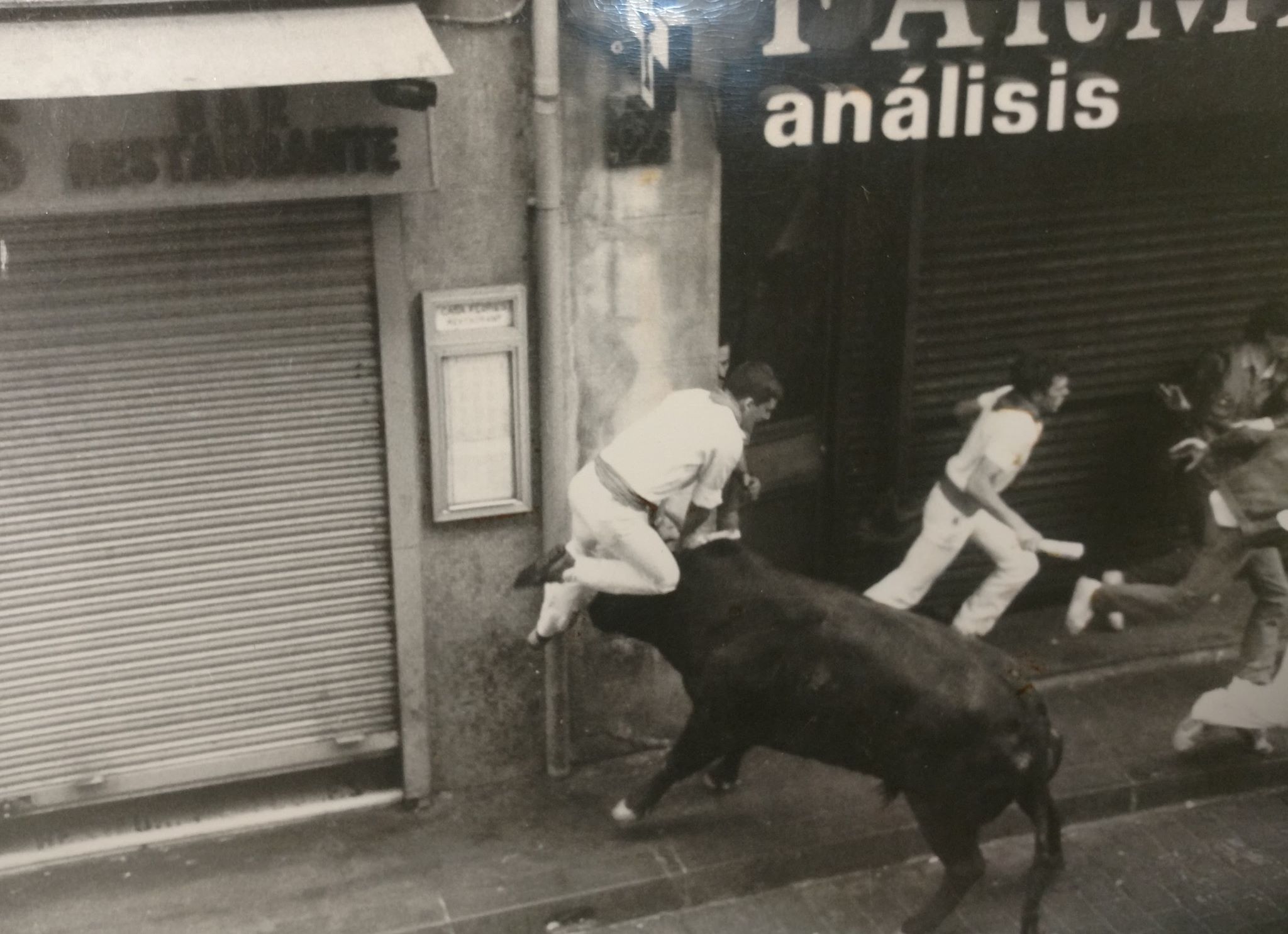
At Bar Txoko, I saw Shred and Bomber and the others who had just run. Cliff and John had also had close calls with the horns. They were trying to avoid the two sueltos that were goring people in Telefonos. It had been an historic day for gorings and injuries, with three animals all goring people at the last section of the encierro before entering the plaza de toros. I also witnessed great acts of bravery. One runner who was trying to save Townsend, was pulling the bull by its tail and then reaching from behind and grabbing its testicles and pulling. The bull barely noticed and instead concentrated on mauling its prey. We were all trading notes and had lots to talk about. I remember saying to GT, “That was really heavy! Is it always like that!!? WTF!!!”. We had started drinking and I wasn’t the only one with an adrenaline high. All of us were flying and the beer and wine hardly made a dent. We hadn’t eaten yet and didn’t mind. Our appetites were suppressed and time was flying by now. By early afternoon we wandered over to a party or enfermeria at the Eslava Hotel.
I met Matt Carney at the Txoco that morning and he invited us all to the party. He was holding court at the bar, drinking with some of the local Basque runners who grew up on the streets of Pamplona and were well known as expert coreadores. James Michener had featured Matt in his book Iberia and highlighted Matt’s fame as the premier American Runner at the time. He also recounted the time when Matt Carney and Hemingway got into an argument and there were harsh words and threats exchanged. Matt, the ex US Marine, was in his prime and would have won any contest or fight. It started when Matt offered Hem a drink from his bota. The cap was loose and one of Hem’s friends accused Matt of setting Hem up, and having his bota pour out all of its wine at once, making a mess, instead of a long drawn-out stream, which is traditional and preferred. The cap being loose was not intentional. It was a misunderstanding blown out of proportion by the sycophants Hem was getting drunk with. Hem made a big deal out of the incident and got out of his chair and made toward Matt. His entourage “held” him back in a comical display of the indignant artist defending his image and honor. Nothing happened.
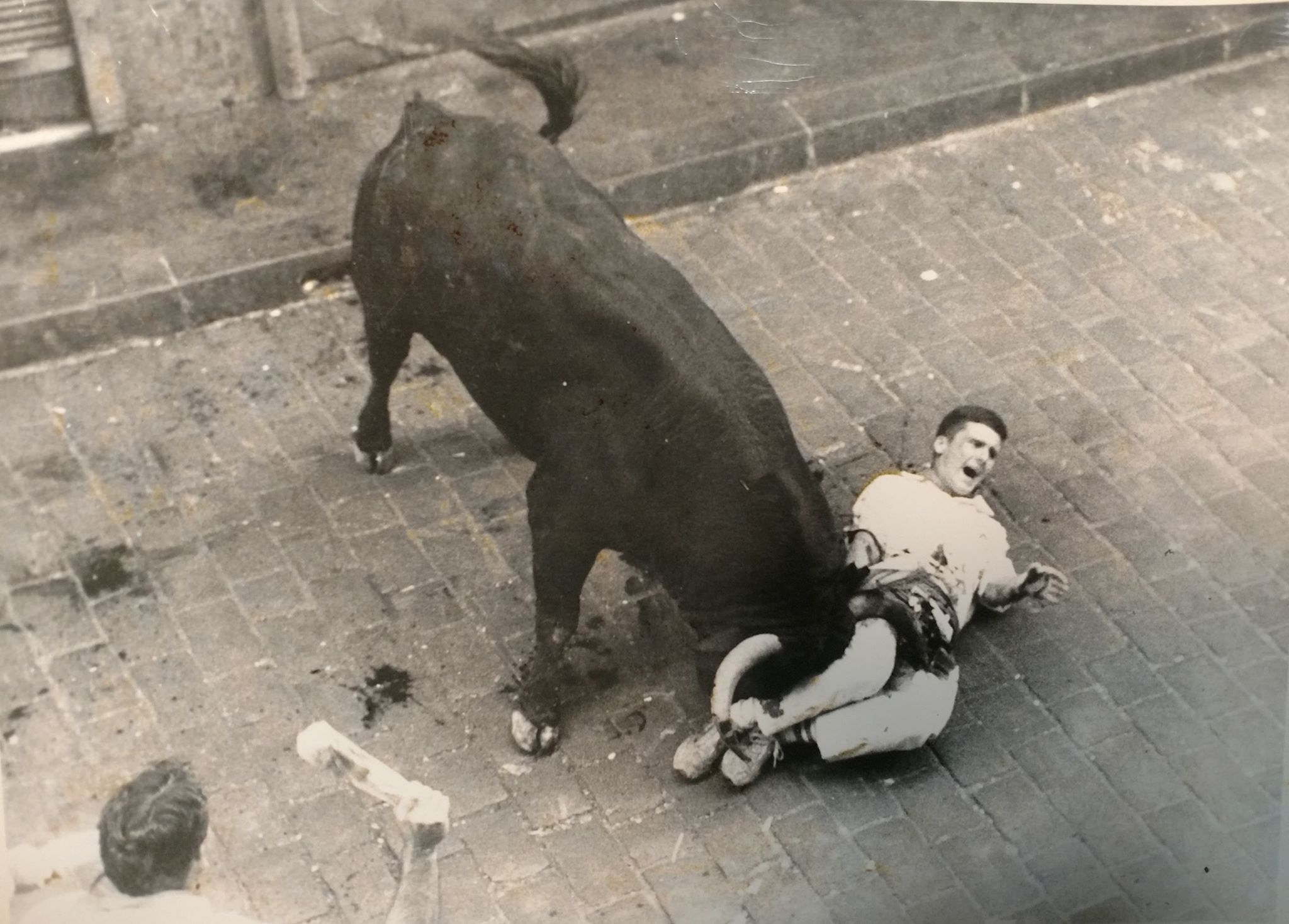
Matt had charisma and people were drawn to him. He was handsome and told great stories. When I met him he was with the local runners discussing what had just happened in the street and all agreed what a dangerous day it had been. We all wondered if the man who was badly gored had survived. We didn’t know his name or nationality yet. Matt was standing with Attanasio and his friends from the Anaitasuna Pena, which Matt belonged to and had the honor as the only foreigner made a member of their club for runners. They were all wearing the traditional colors of white and red. White clothing with a red scarf around their neck and a red sash around their waist. The red panuelo around their necks had the crest of the Anaitasuna pena, one of the oldest penas in Pamplona.
In the basement of the Eslava Hotel, we drank the traditional “red shit and yellow shit”. Buckets filled with Bloody Marys and Screw-drivers. Our host , Magoo, had also put some tapas out to soak up the booze and help us stay awake. Matt was telling us about the traditions of fiesta and how important it was to respect the locals and try to understand what it means to be Basque. He spoke about how they had struggled and were repressed under Franco, and why they are so proud of their heritage. Ten years before, it was illegal to speak in Basque or sing their songs or dance their jotas. Ten years later there was a resurgence of culture but the Basque were still under siege from the government.This was because hard-line separatist members of ETA were demanding their own country and had initiated a campaign of assassinations and bombings throughout Spain and was promoting autonomy through violent revolution. Many ETA members came to Pamplona for the Festival of San Fermin despite being wanted by police, military and secret hit squads from Madrid.
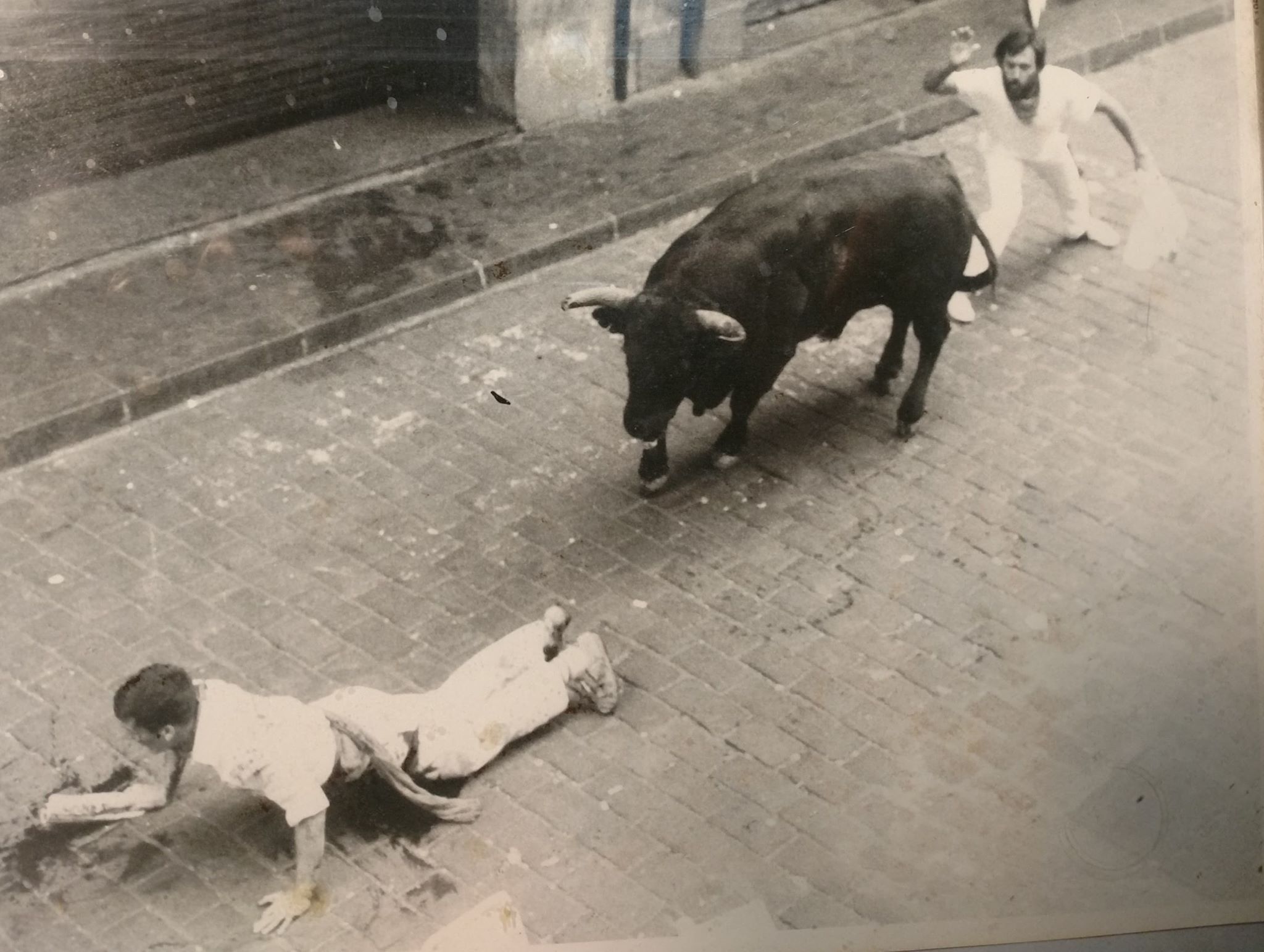
We were enthralled by Matt’s understanding of the locals and his advise about fiesta and how to run bulls. Later on Matt recited ‘The Raven” by Poe and the room fell silent. He then started to sing an Irish song, “Wearin’ of The Green”. I handed Matt a refill and he asked about me and how I came to Pamplona. I told him about my Dad and my uncle who were both Marines. My Uncle Jim Dwyer was a veteran of the battles on Tarawa, Wake Island, and Guadalcanal. He knew and was friends with John Basilone. He was punished after Guadalcanal for beating up an artillery Major in the middle of battle because he was shelling his troops. He had been The Sergeant Major of Guantanamo Bay for two years when he was forced to become a Lieutenant just before the attack on Guadalcanal. Punishment took a crooked turn, and he was promoted to Captain but given command of a naval Brig in San Francisco. He hated this assignment and drank himself out of the Marines. Matt asked about me; my education, what I was doing in Germany for the US Army, my trip through Africa, and what I thought about Pamplona. Then he asked how my run was today and I told him about where I was and what I saw and where I ended up. He was clapping me on the back and saying my baptism by fire was special and I would never have another first run or be as scarred again because now I was a “Veteran”! He was leaving to go to the corrida and said he would see me in the morning in the street and gave me an abrazo fuerte. He reminded me of my Dad and had certain mannerisms and a cadence in his tone of an old Marine. A confident bering and square shoulders and a clean pressed uniform with ribbons and medals. Matt had a gift for making you feel important when he talked to you. It was part of his charm and he was good at it. He would put both hands on your shoulders and look you in the eye and then say his piece. It was easy to see why he was so admired.
Soon it was time to leave for the bull fights. I didn’t have tickets, so we got more beer and went to the park and took a nap. Robert found us later and told us that our car had been broken into and some of our bags were stolen. I lost one out of two bags and all my clothes. I had hidden my documents and money and valuables in the car and they weren’t taken. I had the clothes on my back and a jacket. A friend let me put my bag in his hotel room at La Perla. Shred also had most of his stuff stolen. We wandered through the town and back down to the mussel bar and the statue where people were diving off. GT called this part of town “Apocalypse Now”. It was darker and dirtier than the rest of the old town and is near where the Punk Rockers sleep on the sidewalks during fiesta. We stayed out all night and spent a few hours in a hard chair, napping before the run.
The horror of the day before was today’s headlines. My picture was on the front page of Navarra Hoy with Townsend and a suelto coming at us. There many pictures of townsend being attacked. It made clear how lucky I was not to have been gored.
We all gathered in front of Ayuntamiento and waited together. Matt came over greeting all of us and saying “Suerte”. He told me that he had seen the newspapers already and saw my picture standing near Townsend and to find him after the run to talk about it. We walked up the street as a group and Matt stayed at the bottom of Calle Estafeta. I went back to where I was the day before. Shred was across the street from me with Bomber and a few others, near the bus stop and Bar Fitero. The first rocket went off and 6 seconds later another. All the bulls were now out of the pen and running. A minute later we heard the crowd screaming at the bottom of Estafeta as the bulls rounded the curve and started up the street. The sound got louder as they got closer. I saw the lead bulls all in a tight pack quickly coming toward us. The pace of the herd is out running anyone in front it and parting the crowd. I don’t see an opening and the pack passes by so quickly that when I start running they are all ahead of me and I am trying to catch up but miss my shot. I run with the crowd and into the arena to see the bulls exit the plaza into their pens on the otherside. It was a fast time of 2.08 minutes. Clean and quick. We stayed in the plaza for the vacas and then went back to Txoco for a drink and a head count. I now understood how special my first run was because of how different today’s run was.
I saw Matt with his pena brothers in front of the Txoco. I was sitting with Art and Tim and Curly and GT. He came over and joined us. The conversation quickly covered the days uneventful run. Rapido y limpia. When the bulls are moving that fast it’s hard to get in front of them to set up for a run. None of us got any time with the bulls that day. Matt turned the attention to that days paper and my photo on the front page. “Your in a bad spot there, against the wall with a suelto looking at you. Pretty exciting first run though, eh?”. The whole table laughed. “Next time, if you can, take the middle of the street instead of the sidewalk, you have more room to move.”. “Can I run with you one of these days?”. “Well , sure. Why not!? Maybe tomorrow, we’ll play it by ear.”.
We spent the day swimming at the waterfalls and napping in the sun. My car mates were talking about leaving Pamplona early and driving to the Montreux Jazz Fest in Switzerland. I was against this idea and argued with Robert, but he who rents the car and has the keys, makes the rules and after the next days bull run my ride would be leaving with or without Chris.
The next few days were a blur of bars and naps in hard metal chairs. I ran each day but never got to run with Matt that year. I was sleeping in doorways and the park. After the runs I hung out with Curly and GT and Art and Tim and Jerry. All my buddies from Garmisch were gone. My clothes were dirty and stained with red wine and blood, I had been wearing them since my first day in Spain. The morning of the 14th I got a ride out of town with Jim from Heidelberg. At the French border I switched with him and drove north. We stopped outside Paris for a short break and saw the fireworks of Bastille Day over the city. When we reached Heidelberg he dropped me off at the train station and after stopping in Munich and enjoying a bratwurst and Helles at my favorite Kiosk in the Hauptbahnhof, I was back in Garmisch that afternoon.

